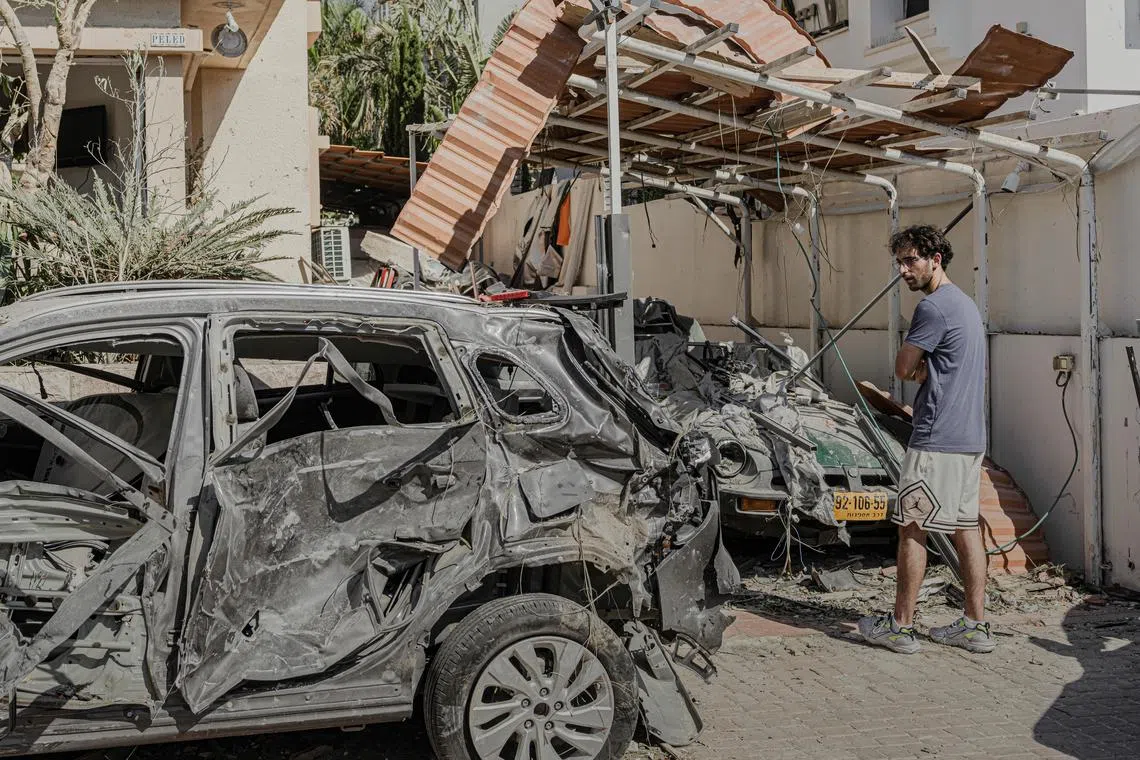‘I was afraid I’d die’: Iran’s missiles rain down on Israel
Sign up now: Get ST's newsletters delivered to your inbox

A resident surveys damage outside of his home, which was hit by an Iranian missile in Rishon LeZion, Israel, just south of Tel Aviv, on June 14.
PHOTO: AMIT ELKAYAM/NYTIMES
Johnatan Reiss
Follow topic:
TEL AVIV - A chorus of alarms from damaged cars and buildings wailed on the afternoon of June 14 through the empty streets of central Tel Aviv in Israel. Iran’s missile attack the night before had left a gaping hole in one high-rise building, and had blown out windows for a block.
Ten kilometres south, residents of the quiet suburb of Rishon LeZion were piling up shattered roof tiles and glass along the pavements after a projectile killed two of their neighbours in a two-storey home on the morning of June 14. Those who lived close to the impact site were busy gathering their belongings to evacuate to temporary housing.
The Israeli government said 17 missile impact sites had been identified across the country after Iran launched hundreds of missiles and drones at Israel between the evening of June 13 and morning of June 14. The strikes were in retaliation for Israeli attacks earlier in the day. Three civilians in Israel were killed and more than 170 wounded, including seven soldiers, the authorities said.
It was not immediately clear whether the damage and deaths had been caused by the missiles themselves, interceptors sent to shoot them down, or falling fragments of both. The Israeli military said missiles and interceptors had hit areas in Israel, but declined to give details.
The damaged high-rise building in central Tel Aviv was near a government quarter and the military’s headquarters. Residents who had evacuated from their high-rise complex after it was struck on June 13 lined up to speak with a municipal official at a makeshift checkpoint near the impact site. Many appeared shaken.
Ms Amit Tzur-Amrani, 26, said she and her husband were huddled in a fortified room in their apartment on June 13 when the air-raid alarms went off after 9pm. Then there was a loud blast, and smoke poured into their shelter.
“We covered our faces with towels to escape,” she said. “I was afraid I’d die in the shelter.”
Struggling to see in the dark, they ran through a hallway and found their entire floor was wrecked. “You couldn’t recognise anything,” she said. “There’s no more house.”
Like dozens of residents in the area, she will be housed in a hotel until the building can be made habitable again. Because her building was directly hit, Ms Tzur-Amrani will not be allowed to enter it to retrieve her belongings for at least a week, the municipal office said.
People from the Rishon LeZion suburb – and some curious visitors – came out to inspect the damage done by a strike that had killed two people in a two-storey home, one of hundreds of houses in the dense neighbourhood of palm-lined streets, cul-de-sacs and alleys.
Shards of glass and plastic littered the street for at least 90m. Cars had shattered windscreens, and many houses were missing roof tiles.
The sight was not entirely unfamiliar to residents. Rishon LeZion, like other cities in central and southern Israel, had previously been hit by some of the thousands of rockets launched from the Gaza Strip since the Oct 7, 2023, Hamas attack that ignited the war there.
“We are already practised,” said Mr Tzabari Malachi, 65, who lives near the destroyed home. On June 14, he watched the tumult on the street from his balcony.
Still, he said, the effect of the recent strikes in his neighbourhood is different, materially and emotionally.
Mr Malachi said he was at home with his wife, sons and two of his small grandchildren when the missile hit, around 5am on June 14. The impact shook his house and blew open the door to his fortified room. After a few minutes, he emerged onto the street to see ambulances and bloodied people rushing for help.
“It’s harrowing, beyond explanation,” he said. NYTIMES

